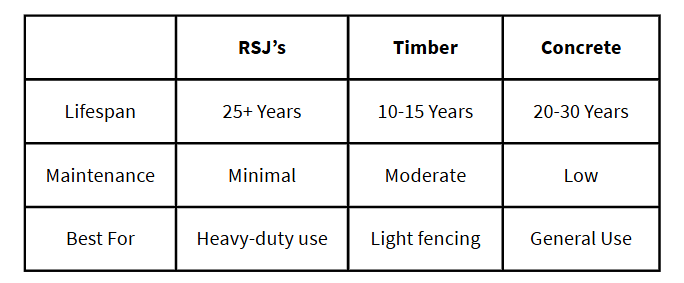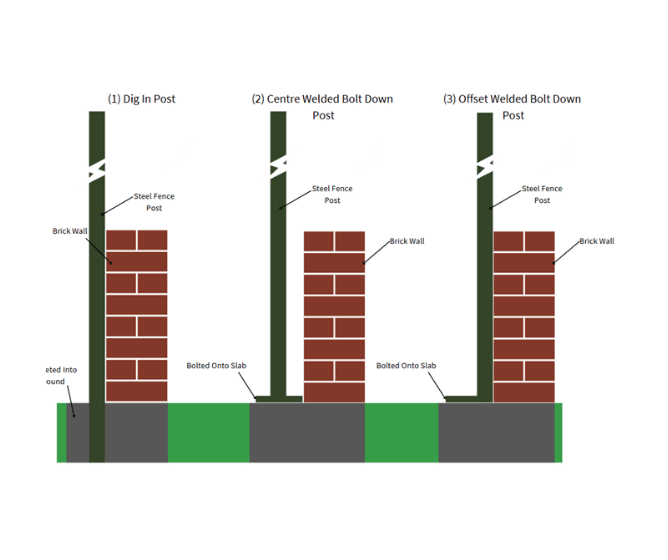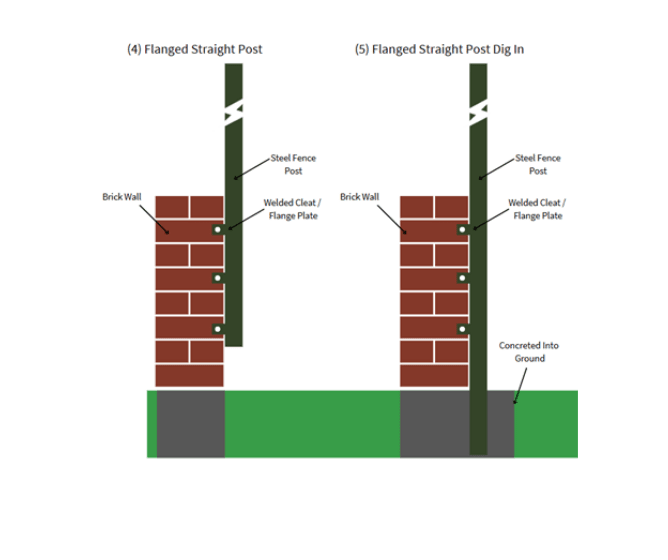First Facts: What is an RSJ and Cranked Posts?

At a Glance
What is an RSJ?
RSJ stands for Rolled Steel Joist. It’s a strong, heavy-duty steel beam commonly used in construction and structural applications.
Types of Cranked Posts
Learn about the different types of cranked posts and which would work best for your project.
Understanding Cranked Posts
Cranked posts are RSJs that feature an angled or ‘cranked’ section, allowing for an offset above ground.
Discover Zinc Spray
Understand why zinc spray is the unsung hero of fencing installation and how a few minutes of prevention can save years of maintenance.
Fence posts may seem like a straightforward topic; in essence, a post does one job. However, there are often wider considerations in fencing, such as ‘Should I dig my post into the ground’ or ‘Is this post actually strong enough to support this height of fence?’
Understanding RSJ’s
What is an RSJ and why should we use it for fencing?
RSJ stands for Rolled Steel Joist, a heavy-duty steel beam originally used in construction. In fencing, it delivers exceptional strength and stability, making it ideal for high-stress areas like gate posts.
They are used for fencing because they are:
- Extremely durable
- Ideal for high-stress points
- Resistant to rot, weather, and wear
- Long-lasting with minimal maintenance
Where are RSJs used?
- Gate posts for wide or heavy gates
- End and corner straightening posts
- High-tension fencing sections
- Agricultural and industrial fencing
RSJ’s vs Traditional Posts

Sizes and Options
We offer a range of RSJ sizes to suit various fencing requirements. All beams can be cut to length and treated if needed.
Install Tips: Set in concrete for secure anchoring, measure carefully and apply rust protection (zinc spray - see below).
Understanding Cranked Angled RSJs
What are Cranked RSJ Posts?
Cranked posts are RSJs that feature an angled or cranked section, allowing for an offset above ground. This design helps align gates or fence panels while keeping the post set back from the fencing line or opening.
Understanding Post Types
To begin, it’s essential to understand the different post-installation methods, specifically the differences between installation types.

1. Dig-In Post
A dig-in post is where excavation is required to insert a portion of the post into the ground, and is typically secured with concrete.
2. Centre Welded Bolt-Down Post
This is a standard style for most bolt-down systems. Note that the actual post length is often slightly shorter than the fence height, as the thickness of the base plate is taken into account. The post is then bolted to solid ground using ground screws, resin, or other mechanical fixing methods.
3. Offset Welded Bolt-Down Post
In this setup, the post is welded to the edge, making it ideal for gapless systems. This is particularly useful when bolting next to walls or plinths and can often be required for end posts. Again, the post length is slightly shorter than the fence height due to the base plate thickness.
Understanding Cranked Angled RSJs

4. Flanged Straight Post
This post is mechanically fixed through the face of a wall or plinth, using lugs or cleats that are welded to either side of the post in multiple locations, helping to spread the load.
5. Flanged Straight Post Dig-In
For additional stability, when the ground conditions are too granular, a post can be flanged for added strength from the supported wall.

6. 50% Cranked Flanged Post
This type is used when the fence line needs to run 50% of the depth of the wall. It is achieved by cutting the post with two 45-degree mitre cuts, welding them together to create a ‘dog leg’. This post is often flanged in two directions, through the face of the wall and from above, providing additional strength. The vertical post for mounting the fence can be set to any distance, but a common standard is 50% of the depth of a brick wall.
7. Fully Cranked Flanged Post
This is used to prevent potential climbing issues on a wall ledge. The fence line can hang completely in line with the edge of the wall or plinth. This is achieved by cutting the post with two 45-degree mitre cuts and welding them together to form a ‘dog leg’. Like the 50% cranked post, it is often flanged in two directions, through the face of the wall and from above, for added strength.
A Closer Look at Cranked Posts
A defining feature of cranked posts is the flange plates, which are welded to either side of an RSJ, Square Hollow Section (SHS), or Rectangular Hollow Section (RHS). These plates are typically made from 5 mm-thick steel and used on systems ranging from 1.8m to 3.0m in height. Most posts have four to six mounting points.
Installation requires drilling holes that align precisely with the flange plate holes. The post is then fixed in place using resin and studding, which is secured with washers and standard nuts. For best results, avoid using shear nuts, as they break at 17-21kN, which can compromise stability. Instead, opt for a non-security nut capable of a higher torque - offering a stronger, more stable fit with less risk of movement over time.
Remember: Not every wall, slab, plinth, or site is the same, meaning that a custom drawing is often required to ensure the load is evenly distributed, depending on the material being bolted to.
First Fence offers a comprehensive bespoke drawing service, tailoring the design of cranked posts to meet your specific site requirements.
Protecting RSJs with Zinc Spray
Protecting Your RSJs
Once your RSJ or cranked post is installed, proper protection against corrosion is essential, especially in outdoor, agricultural environments where exposure to moisture and the elements is constant. Also, if you have had to cut down one of your RSJ posts, it is being exposed to weathering.
One of the most effective ways to do this is by applying a zinc-rich spray. This spray can save years of maintenance and only takes a few minutes!
A Quality Zinc Spray Works in Two Ways
Barrier Protection: The spray creates a physical barrier, sealing the exposed mild steel from the corrosive effects of rain, dew, and humidity.
Galvanic Protection: This is the clever bit. Zinc is a more reactive metal than steel. This means that if any moisture does find its way to the steel, the zinc in the spray will corrode first, essentially sacrificing itself to protect the steel, maintaining the structural integrity of your fence post or anchor.
Why Zinc Spray Should be in Every Fencer’s Toolkit?
For fencing professionals and DIYers alike, zinc spray is a must-have. Any time you cut galvanised steel, whether it’s a post, rail, or fixing, you expose raw steel that’s vulnerable to rust.
When to Use Zinc Spray
- After cutting galvanised posts, rails, or fittings
- On drilled holes or welds
- As a touch-up for scratched or damaged coatings
How to Apply Zinc Spray
- Clean and dry the cut or exposed area
- Shake the can thoroughly to mix the contents
- Spray a thin, even coat onto the exposed steel
- Let it dry completely
- Apply a second coat for added protection (optional but recommended)
Get More From First Fence
First Fence offers a wide range of high-quality galvanised products designed to withstand the toughest of conditions. Each of our products is manufactured to meet strict industry standards, ensuring durability and strength.
Download the PDF version of First Facts: What is an RSJ and Cranked Posts?












